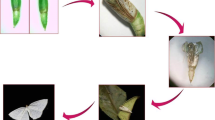Summary
Individually-housedDrosophila melanogaster show a gradual bimodal rise in egg production with a major crest shortly after dusk. The crest drifts toward noon after 2 to 3 days. The rhythm is hourglass.
Similar content being viewed by others
References
R. Allemand, J. Insect Physiol.22, 1075 (1976).
P. Farb, in: Ecology: Life Nature Library, p. 74. Time, Inc., New York 1963.
G. Gruwez, C. Hoste, C. V. Lints and F. A. Lints, Experientia27, 1414 (1971).
L. Rensing and R. Hardeland, J. Insect Physiol.13, 1547 (1967).
J. David and P. Fauillet, Rev. Comp. Anim.7, 197 (1973).
D. D. Sameoto and R. S. Miller, Ecology47, 695 (1966).
J. Aschoff, Ecology47, 657 (1966).
S. B. Yoon and A. S. Fox, Nature206, 910 (1965).
Author information
Authors and Affiliations
Additional information
I thank L. Cutkomp for the use of his facilities and material help during the initial stages of this study.
Rights and permissions
About this article
Cite this article
Fluegel, W. Oviposition rhythm of individualDrosophila melanogaster. Experientia 34, 65–66 (1978). https://doi.org/10.1007/BF01921905
Published:
Issue Date:
DOI: https://doi.org/10.1007/BF01921905




